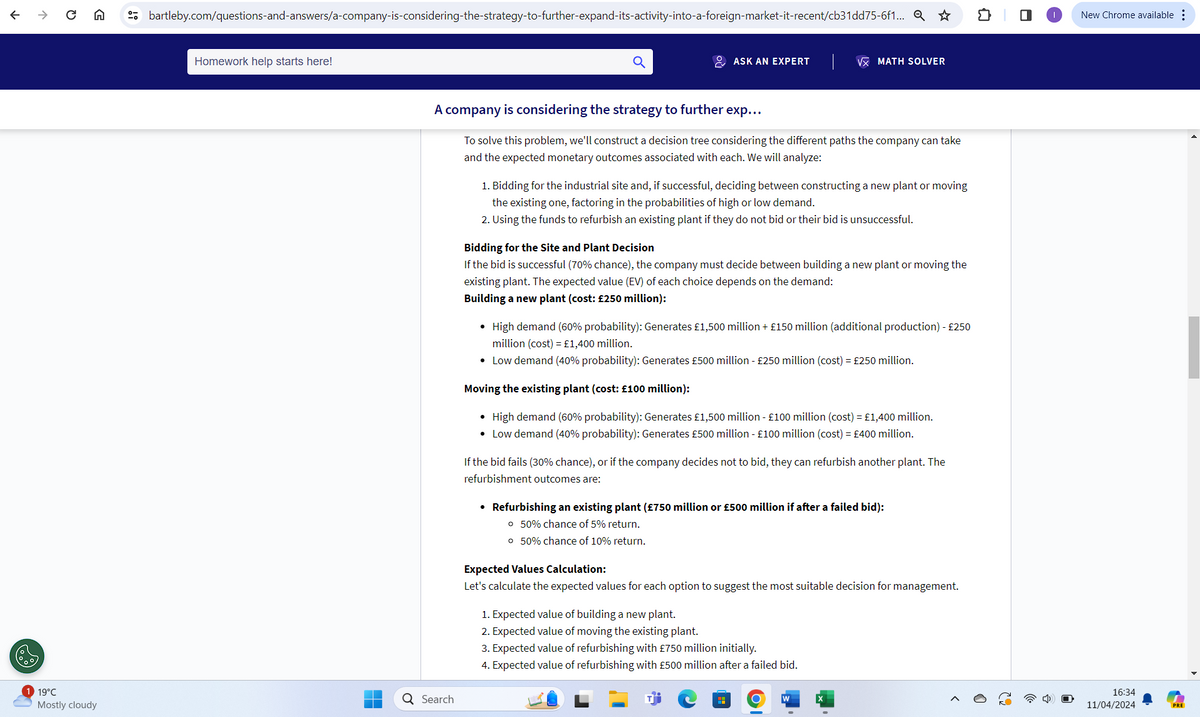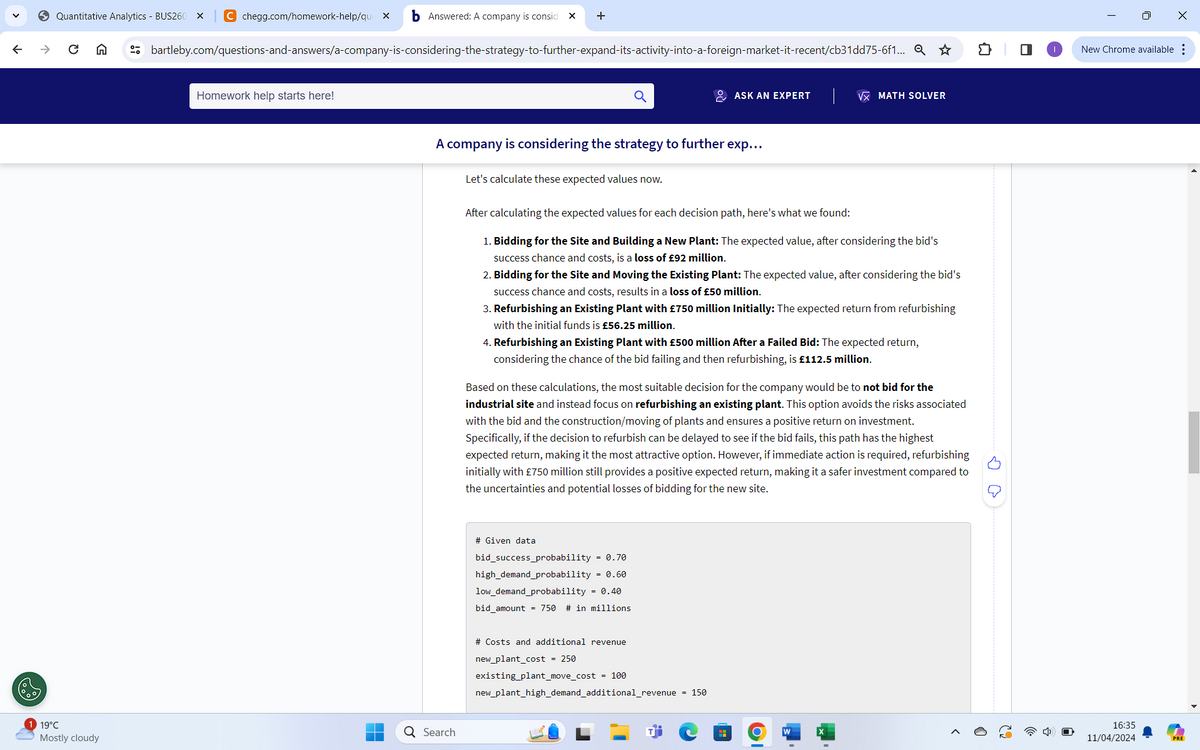个 个 ^ Ω G bartleby.com/questions-and-answers/a-company-is-considering-the-strategy-to-further-expand-its-activity-into-a-foreign-market-it-recent/cb31dd75-6f1... Q☆✩ ខ New Chrome available 19°C Mostly cloudy Homework help starts here! = Q ASK AN EXPERT VX MATH SOLVER A company is considering the strategy to further exp... To solve this problem, we'll construct a decision tree considering the different paths the company can take and the expected monetary outcomes associated with each. We will analyze: 1. Bidding for the industrial site and, if successful, deciding between constructing a new plant or moving the existing one, factoring in the probabilities of high or low demand. 2. Using the funds to refurbish an existing plant if they do not bid or their bid is unsuccessful. Bidding for the Site and Plant Decision If the bid is successful (70% chance), the company must decide between building a new plant or moving the existing plant. The expected value (EV) of each choice depends on the demand: Building a new plant (cost: £250 million): • High demand (60% probability): Generates £1,500 million + £150 million (additional production) - £250 million (cost) £1,400 million. • Low demand (40% probability): Generates £500 million - £250 million (cost) = £250 million. Moving the existing plant (cost: £100 million): • High demand (60% probability): Generates £1,500 million - £100 million (cost) = £1,400 million. • Low demand (40% probability): Generates £500 million - £100 million (cost) = £400 million. If the bid fails (30% chance), or if the company decides not to bid, they can refurbish another plant. The refurbishment outcomes are: • Refurbishing an existing plant (£750 million or £500 million if after a failed bid): • 50% chance of 5% return. • 50% chance of 10% return. Expected Values Calculation: Let's calculate the expected values for each option to suggest the most suitable decision for management. 1. Expected value of building a new plant. 2. Expected value of moving the existing plant. 3. Expected value of refurbishing with £750 million initially. 4. Expected value of refurbishing with £500 million after a failed bid. Q Search W x > 0 16:34 11/04/2024 PRE > C A Quantitative Analytics - BUS260 C chegg.com/homework-help/que x Answered: A company is consid + Homework help starts here! bartleby.com/questions-and-answers/a-company-is-considering-the-strategy-to-further-expand-its-activity-into-a-foreign-market-it-recent/cb31dd75-6f1... Q☆ វា П 19°C Mostly cloudy Q Search ASK AN EXPERT VX MATH SOLVER A company is considering the strategy to further exp... Let's calculate these expected values now. After calculating the expected values for each decision path, here's what we found: 1. Bidding for the Site and Building a New Plant: The expected value, after considering the bid's success chance and costs, is a loss of £92 million. 2. Bidding for the Site and Moving the Existing Plant: The expected value, after considering the bid's success chance and costs, results in a loss of £50 million. 3. Refurbishing an Existing Plant with £750 million Initially: The expected return from refurbishing with the initial funds is £56.25 million. 4. Refurbishing an Existing Plant with £500 million After a Failed Bid: The expected return, considering the chance of the bid failing and then refurbishing, is £112.5 million. Based on these calculations, the most suitable decision for the company would be to not bid for the industrial site and instead focus on refurbishing an existing plant. This option avoids the risks associated with the bid and the construction/moving of plants and ensures a positive return on investment. Specifically, if the decision to refurbish can be delayed to see if the bid fails, this path has the highest expected return, making it the most attractive option. However, if immediate action is required, refurbishing initially with £750 million still provides a positive expected return, making it a safer investment compared to the uncertainties and potential losses of bidding for the new site. # Given data bid_success_probability = 0.70 high demand probability = 0.60 low_demand probability = 0.40 bid amount = 750 # in millions # Costs and additional revenue new_plant_cost = 250 existing_plant_move_cost = 100 new_plant_high_demand_additional_revenue = 150 16:35 11/04/2024 PRE I | 0 New Chrome available ×
Hello so I asked for an expert to answer this question and I wanna ask more but I am not sure how to here is the question: Also the question isnt linked from any other site its from bartleby
A company is considering the strategy to further expand its activity into a foreign market it recently accessed. The foreign government has announced that a new industrial site will be offered for sale on a competitive tender basis, the site going to the company making the highest bid. The multinational has a good experience with this type of auctions, and – based on its assessment – it decides that if it is to bid for the site, it will place a bid of £750 million. In the past, 70 percent of the company’s bids for such type of projects have been successful.
The marketing department indicates that expansions of the multinational’s foreign market activity can be expected to generate revenue of around £1,500 million if
If the company is successful in its bid, it will also have to decide whether to construct a new plant for the site or to move an existing plant which has proven to be inefficient. Building the new plant from scratch costs £250 million, while moving the existing plant costs around £100 million. However, in case demand proves to be high, the new plant, equipped with state-of-the-art technology, would boost production by an additional £150 million.
The same multinational company is also under pressure to refurbish another of its existing plants. The £750 million could be used for this purpose, instead. If the money is used for refurbishment, there is a 50 percent chance of increasing efficiency to generate a return of 5 percent on the £750, and a 50 percent chance of generating a return of 10 percent. If the decision to refurbish takes place after the bid has been made and failed, £500 million will be invested for refurbishment.
First I asked this: 1)Construct a decision tree for this problem and suggest a suitable decision for management.
In picture one and two is the answer he gave me.
Now I want you to answer this two please:
What is the maximum bid the company should consider? What is the value of perfect information about foreign market demand?
AND
Can you explain why and how your answer in part A would change, if management had different attitude to risk (pessimistic vs optimistic)?


Step by step
Solved in 2 steps









